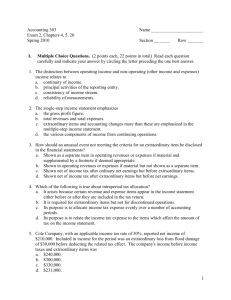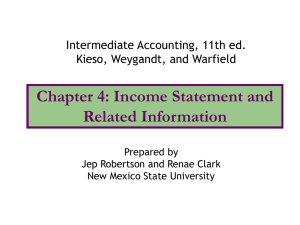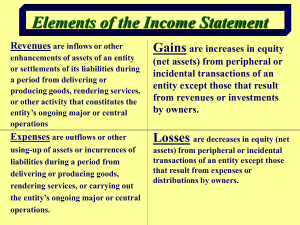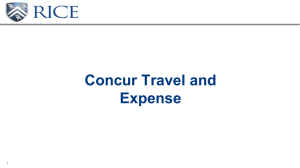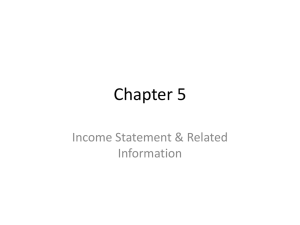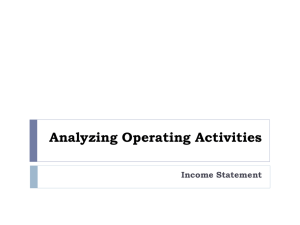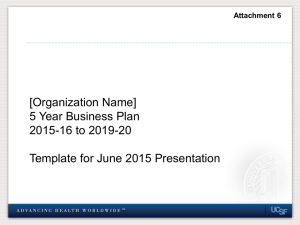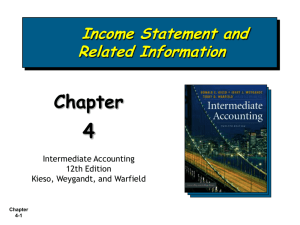Slides
advertisement
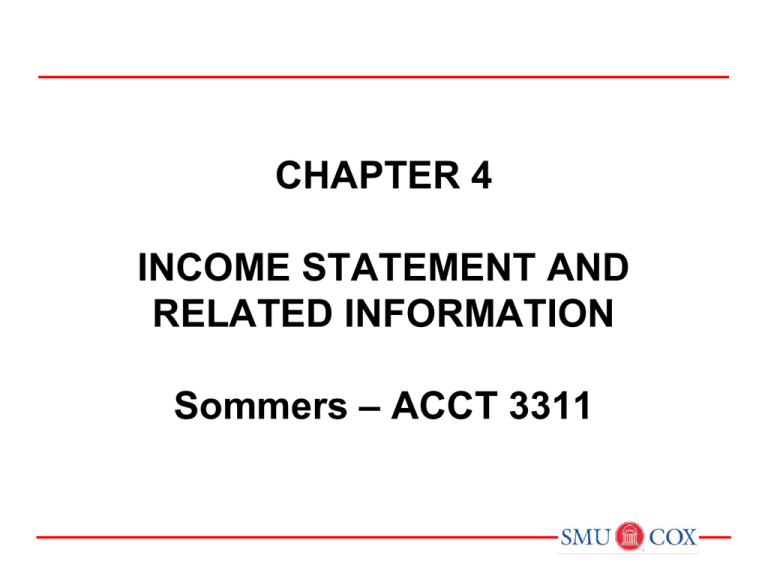
CHAPTER 4 INCOME STATEMENT AND RELATED INFORMATION Sommers – ACCT 3311 Discussion Question Q4-1 What kinds of questions about future cash flows do investors and creditors attempt to answer with information in the income statement? Income Statement Usefulness Evaluate past performance. Predicting future performance. Help assess the risk or uncertainty of achieving future cash flows. Income Statement Limitations Companies omit items that cannot be measured reliably. Income is affected by the accounting methods employed. Income measurement involves judgment. Discussion Questions Q4-3 Identify at least two situations in which important changes in value are not reported in the income statement. Discussion Question Q4-8 Why should caution be exercised in the use of the net income figure derived in an income statement? Income Statement Quality of Earnings Companies have incentives to manage income to meet or beat Wall Street expectations, so that market price of stock increases and value of stock options increase. Quality of earnings is reduced if earnings management results in information that is less useful for predicting future earnings and cash flows. Earnings Quality – Operating/Nonoperating Operating Income • Restructuring Costs – Costs associated with shutdown or relocation of facilities or downsizing of operations are recognized in the period incurred. • Goodwill Impairment and Long-lived Asset Impairment - Involves asset impairment losses or charges. Nonoperating Income • Gains and losses from the sale of operational assets and investments - Often can significantly inflate or deflate current earnings. Example: As the stock market boom reached its height late in the year 2000, many companies recorded large gains from sale of investments that had appreciated significantly in value. How should those gains be interpreted in terms of their relationship to future earnings? Are they transitory or permanent? Classification Operating Nonoperating Permanent Transitory Where would the following items lie? •Sales revenue •Restructuring charges •Royalty income •Interest expense •Payment made for settlement of lawsuit •R&D expense Incentives for disclosures that influence user classification? Discussion Question Q4-10 What is the major distinction (a) between revenues and gains and (b) between expenses and losses? Single-Step Format Single-Step Income Statement Revenues Expenses SingleStep Net Income No distinction between Operating and Non-operating categories. Income Statement (in thousands) Revenues: Sales $ 285,000 Interest revenue 17,000 Total revenue 302,000 Expenses: Cost of goods sold 149,000 Selling expense 10,000 Administrative expense 43,000 Interest expense 21,000 Income tax expense 24,000 Total expenses Net income 247,000 $ 55,000 Earnings per share $ 0.75 Multiple-Step Format Multiple-Step Income Statement Separates operating transactions from nonoperating transactions. Matches costs and expenses with related revenues. Highlights certain intermediate components of income that analysts use. Multiple-Step Format Intermediate Components of the Income Statement 1. Operating section 2. Nonoperating section 3. Income tax 4. Discontinued operations 5. Extraordinary items 6. Earnings per share Multiple-Step Format The presentation divides information into major sections. 1. Operating Section 2. Nonoperating Section 3. Income tax Income Statement (in thousands) Sales Cost of goods sold Gross profit Operating expenses: Selling expenses Administrative expenses Total operating expense Income from operations Other revenue (expense): Interest revenue Interest expense Total other Income before taxes Income tax expense Net income $ 285,000 149,000 136,000 10,000 43,000 53,000 83,000 $ 17,000 (21,000) (4,000) 79,000 24,000 55,000 E4-7 The accountant of Weatherspoon Shoe Co. has compiled the following information from the company’s records as a basis for an income statement for the year ended December 31, 2014. Rent revenue $29,000 Interest expense 18,000 Market appreciation on land above cost 31,000 Salaries and wages expense (sales) 114,800 Supplies (sales) 17,600 Income tax 30,600 Salaries and wages expense (administrative) 135,900 Other administrative expenses 51,700 Cost of goods sold 516,000 Net sales 980,000 Depreciation on plant assets (70% selling, 30% administrative) 65,000 Cash dividends declared 16,000 There were 20,000 shares of common stock outstanding during the year. Prepare a multiple-step income statement. E4-7 E4-7 Single Step WEATHERSPOON SHOE CO. Income Statement For the Year Ended December 31, 2014 Revenues Net sales Rent revenue Total revenues Expenses Cost of goods sold Administrative expenses Selling expenses Interest expense Total expenses $ 980,000 29,000 1,009,000 $516,000 207,100 177,900 18,000 919,000 Income before income tax 90,000 Income tax Net income 30,600 59,400 Earnings per share ($59,400 ÷ 20,000) $ $2.97 Income Statement Classifications Reporting Irregular Items Irregular items fall into six categories 1. Discontinued operations. 2. Extraordinary items. 3. Unusual gains and losses. 4. Changes in accounting principle. 5. Changes in estimates. 6. Corrections of errors. Reporting Irregular Items Companies are required to report irregular items in the financial statements so users can determine the long-run earning power of the company. Illustration 4-6 Number of Unusual Items Reported in a Recent Year by 500 Large Companies Reporting Irregular Items Discontinued Operations Occurs when, (a) company eliminates the results of operations and cash flows of a component. (b) there is no significant continuing involvement in that component. Amount reported “net of tax.” Reporting Discontinued Operations Illustration: KC Corporation had after tax income from continuing operations of $55,000,000 for the year. During the year, it disposed of its restaurant division at a pretax loss of $270,000. Prior to disposal, the division operated at a pretax loss of $450,000 for the year. Assume a tax rate of 30%. Prepare a partial income statement for KC. Income from continuing operations Discontinued operations: Loss from operations, net of $135,000 tax Loss on disposal, net of $81,000 tax Total loss on discontinued operations $55,000,000 Net income $54,496,000 315,000 189,000 504,000 Reporting Discontinued Operations Discontinued Operations are reported after “Income from continuing operations.” Previously labeled as “Net Income”. Moved to Income Statement (in thousands) Sales Cost of goods sold Gross profit Interest expense Total other Income before taxes Income tax expense Income from continuing operations Discontinued operations: Loss from operations, net of tax Loss on disposal, net of tax Total loss on discontinued operations Net income $ 285,000 149,000 136,000 (21,000) (4,000) 79,000 24,000 55,000 315 189 504 $ 54,496 P&G’s Income Statement Reporting Irregular Items Extraordinary items are nonrecurring material items that differ significantly from a company’s typical business activities. Extraordinary Item must be both of an Unusual Nature and Occur Infrequently Company must consider the environment in which it operates. Amount reported “net of tax.” Reporting Extraordinary Items Illustration: KC Corporation had after tax income from continuing operations of $55,000,000 during the year. In addition, it suffered an unusual and infrequent pretax loss of $770,000 from a volcano eruption. The corporation’s tax rate is 30%. Prepare a partial income statement for KC Corporation beginning with income from continuing operations. Income from continuing operations Extraordinary loss, net of $231,000 tax $55,000,000 539,000 Net income $54,461,000 ($770,000 x 30% = $231,000 tax) Reporting Irregular Items Reporting when both Discontinued Operations and Extraordinary Items are present. Discontinued Operations Extraordinary Items Income Statement (in thousands) Sales Cost of goods sold Gross profit Income before taxes Income tax expense Income from continuing operations Discontinued operations: Loss from operations, net of tax Loss on disposal, net of tax Total loss on discontinued operations Income before extraordinary item Extraordinary loss, net of tax Net income $ 285,000 149,000 136,000 79,000 24,000 55,000 315 189 504 54,496 539 $ 54,496 Reporting Irregular Items Unusual Gains and Losses Material items that are unusual or infrequent, but not both, should be reported in a separate section just above “Income from continuing operations before income taxes.” Examples can include: Write-downs of inventories Foreign exchange transaction gains and losses The Board prohibits net-of-tax treatment for these items. Reporting Irregular Items Unusual Gains and Losses Illustration 4-7 Income Statement Presentation of Unusual Charges Special Reporting Issues Intraperiod Tax Allocation Relates the income tax expense to the specific items that give rise to the amount of the tax expense. Income tax is allocated to the following items: (1) Income from continuing operations before tax. (2) Discontinued operations. (3) Extraordinary items. Intraperiod Income Tax Allocation Income Tax Expense must be associated with each component of income that causes it. Show Income Tax Expense related to Income from Continuing Operations. Report effects of Discontinued Operations and Extraordinary Items NET OF RELATED INCOME TAXES. Special Reporting Issues Intraperiod Tax Allocation Extraordinary Gain: Schindler Co. has income before income tax and extraordinary item of $250,000. It has an extraordinary gain of $100,000 from a condemnation settlement received on one its properties. Assuming a 30 percent income tax rate. Illustration 4-13 Special Reporting Issues Intraperiod Tax Allocation Extraordinary Loss: Schindler Co. has income before income tax and extraordinary item of $250,000. It has an extraordinary loss from a major casualty of $100,000. Assuming a 30 percent income tax rate. Illustration 4-14 Example of Intraperiod Tax Allocation Income Statement (in thousands) Sales Cost of goods sold Total other $ 285,000 149,000 (4,000) Income from cont. oper. before taxes 79,000 Income tax expense 24,000 Income from continuing operations 55,000 Note: losses reduce the total tax Calculation of Total Tax $24,000 Discontinued operations: Loss on operations, net of $135 tax 315 Loss on disposal, net of $61 tax 189 Total loss on discontinued operations Income before extraordinary item Extraordinary loss, net of $231 tax Net income (135) (61) 504 54,496 539 $ 53,957 (231) $23,573 E4-6B The following balances were taken from the books of Schimank Corp. on December 31, 2014. Assume the total effective tax rate on all items is 34%. Prepare a multiple-step income statement; 100,000 shares of common stock were outstanding during the year. Interest revenue $ 120,400 Accum deprec—equipment $ 56,000 Cash 71,400 Accum deprec—building 39,200 Sales 1,932,000 Notes receivable 217,000 Accounts receivable 210,000 Selling expenses 271,600 Prepaid insurance 28,000 Accounts payable 238,000 Sales returns & allowances 210,000 Bonds payable 140,000 Allowance for bad debts 9,800 Admin & general expenses 135,800 Sales discounts 63,000 Accrued liabilities 44,800 Land 140,000 Interest expense 84,000 Equipment 280,000 Notes payable 140,000 Building 196,000 Loss from earthquake damage Cost of goods sold 869,400 (extraordinary item) 210,000 Common stock 700,000 Retained earnings 29,400 E4-6B
